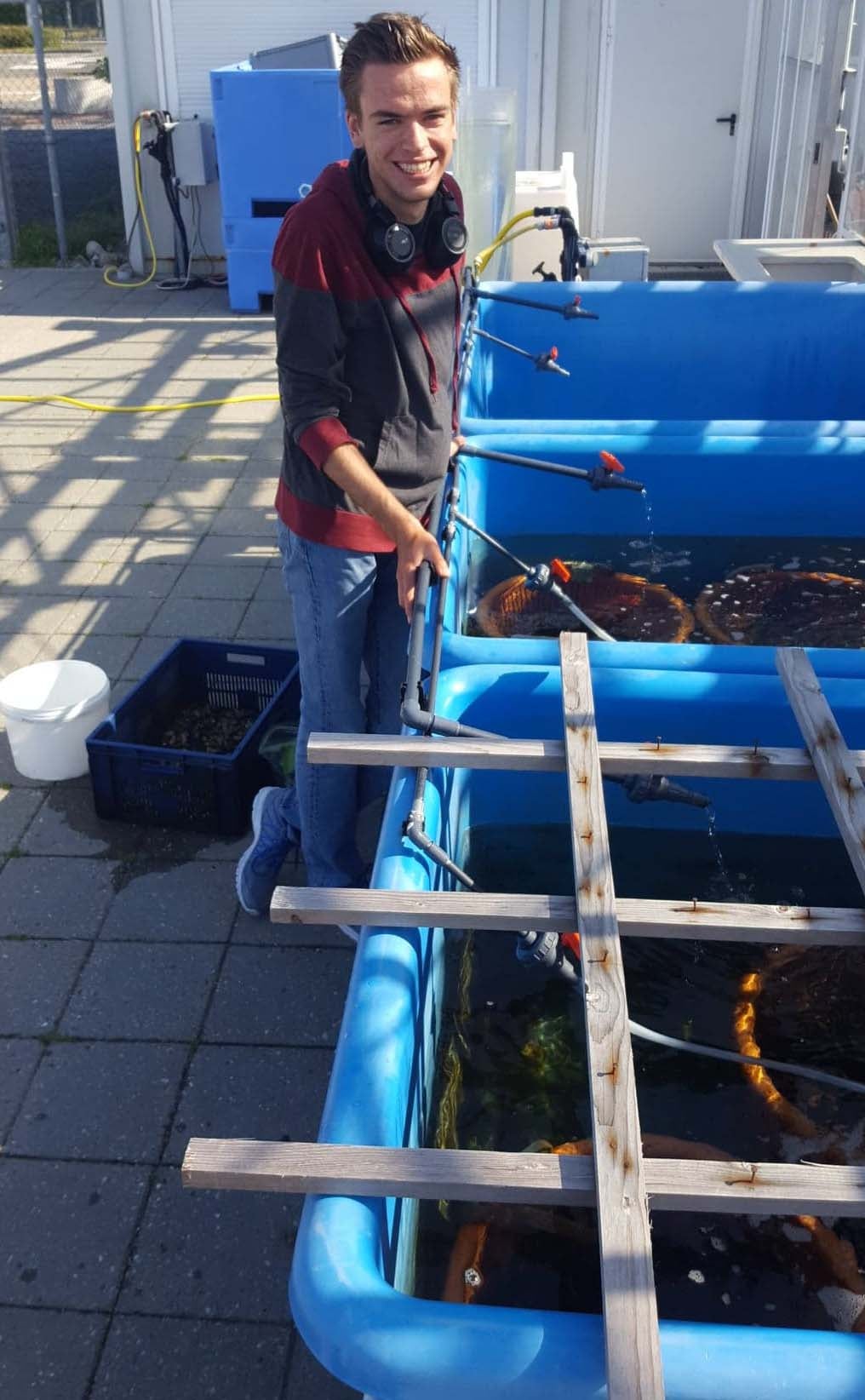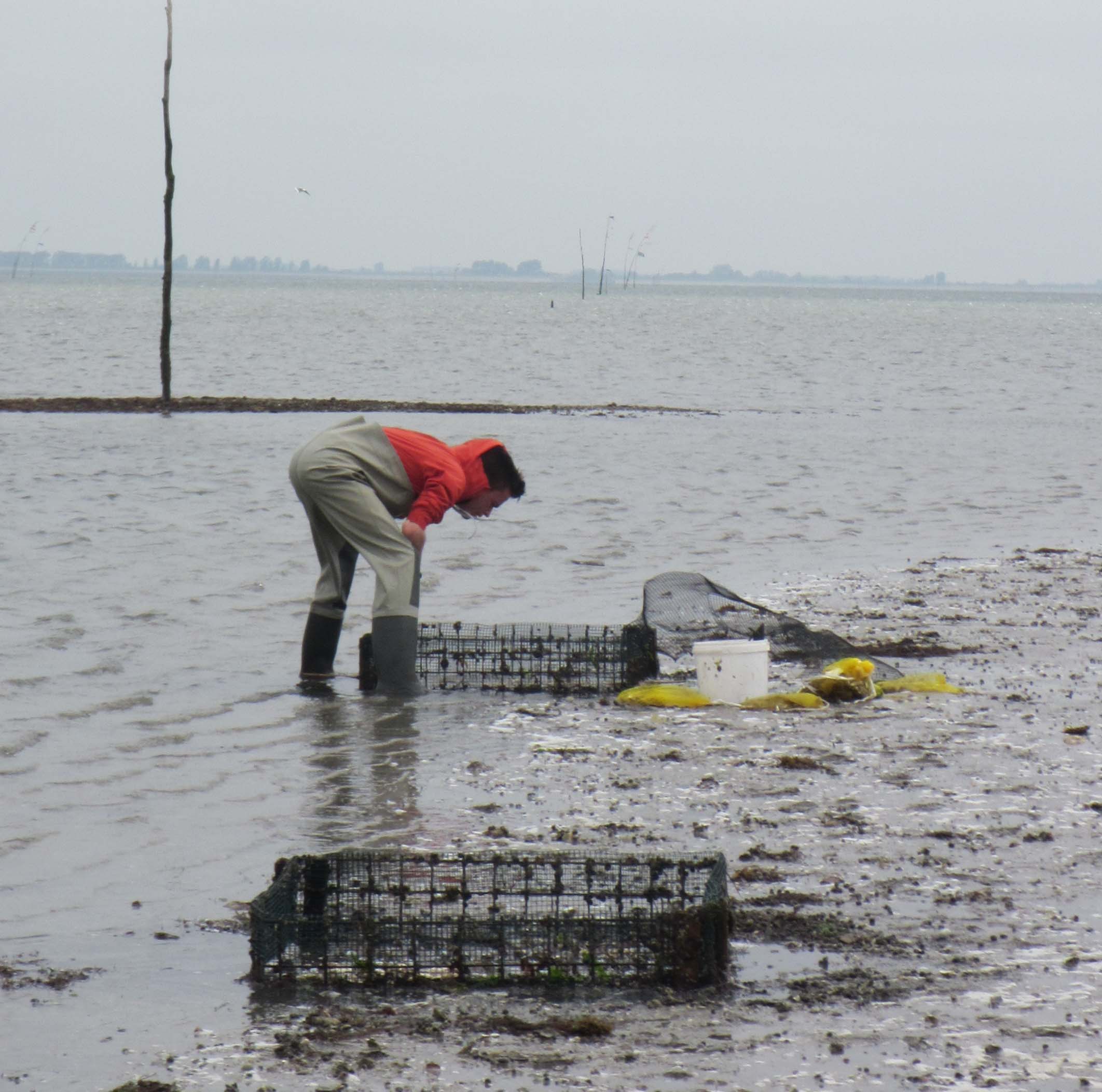
Drilling down on research
Student explored predatory oyster drill eating habits on co-op term

Student explored predatory oyster drill eating habits on co-op term
By Carol Truemner Faculty of EngineeringIt didn’t take long for Calvin Veenkamp to get his feet wet on a 2019 co-op term in the Netherlands.
The second-year environmental engineering student spent four months wading in and out of the inter-tidal zone of the Oosterschelde near the Yerseke, a small town where the main industry is shellfish cultivation.
Veenkamp worked with researchers at HZ University of Applied Sciences in Vlissingen, Zeeland investigating ways of reducing the devastation caused by predatory marine snails, known as Japanese Oyster Drills, on the local oyster industry.
As its name implies, the Japanese Oyster Drill drills a hole in the shell of an oyster and eats it. Over the past 13 years, some oyster plots in the  Netherlands have become home to tens of thousands of oyster drills.
Netherlands have become home to tens of thousands of oyster drills.
“When talking to one of the oyster farmers, I was told that since the Japanese Oyster Drill appeared, many have had to entirely abandon their plots due to infestation,” says Veenkamp. “Those farmers who remain can see anywhere from 60 to 80 per cent mortality among their oyster crop.”
The project Veenkamp took part in is focused on coming up with recommendations for farmers on how to minimize the negative effects of the oyster drills rather than eliminating the predators.
Engineering student Calvin Veenkamp ran two experiments on the feeding habits of the Japanese Oyster Drill on a co-op term in the Netherlands.
“We realized it’s unrealistic to remove all the oyster drills just to have them come back – they breed like crazy,” he says. “So we needed to say ‘hey they’re there, let’s try to work around them.’”
Veenkamp ran experiments on the feeding habits of the oyster drill to discover whether it has a preference for a fertile as opposed to an infertile oyster and whether it is attracted to one with a certain shell size or shape.
Since the gray and brown oyster drills blend in with the environment, he painted them bright green so they could be easily identified.
In the first set of experiments, Veenkamp compared oysters raised in France to those raised in the Netherlands because the different water conditions can affect how they build their shells – the more nutrients in the water, the thicker their shells tend to be.
Two oysters used in the second run of the experiment were from the Netherlands – one with a wavy shell and the other with a smooth shell.
 Findings showed that the oyster drill’s feeding preference was the oyster with the smooth shell, leading Veenkamp and other researchers to hypothesize that it was easier for the predator to attach itself to a smooth shell.
Findings showed that the oyster drill’s feeding preference was the oyster with the smooth shell, leading Veenkamp and other researchers to hypothesize that it was easier for the predator to attach itself to a smooth shell.
Calvin Veenkamp spent four months in and out of the inter-tidal zone of the Oosterschelde.
HZ University researchers are currently working to verify the results of Veenkamp’s second experiment.
“Hopefully they can get those findings again and do something with them,” he says.
A possible solution recommended by Veenkamp and other researchers would be for farmers to spread a preferred prey in a border around their plots to keep the oyster drills away from the cultivated oysters.
Veenkamp summarized his co-op term research in a document that won a Waterloo environmental engineering work-term report award last term.
His Dutch family connection is one of the main reasons Veenkamp chose to spend a co-op term at HZ University, a co-op and exchange term partner of the University of Waterloo.
While delving into the feeding habits of the oyster drill in the Netherlands, Veenkamp immersed himself in the culture of the country where all four of his grandparents were born and raised before immigrating to Canada.
On his second day in the Netherlands, Veenkamp bought a bike for 60 euros and began cycling, a popular form of transportation in the country where bikes outnumber the population.
“I loved the biking there,” he says. “Between every town, no matter how big or small, is a bike path.”
Veenkamp travelled overseas on the same plane as a fourth-year Waterloo environmental engineering student who ended up as his co-op term roommate.
Soon after arriving in Vlissingen, Veenkamp met up with three other University of Waterloo co-op students. The five spent much of their spare time together biking throughout the Netherlands and across its border into other countries, including Belgium.
One of the things that didn’t stand out for Veenkamp during his co-op term?
His height.
At six feet, two inches, Veenkamp quickly noticed he was not one of the tallest in the room.
“Everyone is super tall,” he says with a laugh. “Normally here in Canada, I can see around crowds. Over there, I didn’t stand out in a crowd at all.”

Read more
Here are the people and events behind some of this year’s most compelling Waterloo stories

Read more
Meet five exceptional Waterloo graduate students crossing the convocation stage as Class of 2025 valedictorians

Read more
Meet six world-class researchers, alumni and students who are applying boundary-breaking approaches to redefine sports, recreation and tourism
The University of Waterloo acknowledges that much of our work takes place on the traditional territory of the Neutral, Anishinaabeg, and Haudenosaunee peoples. Our main campus is situated on the Haldimand Tract, the land granted to the Six Nations that includes six miles on each side of the Grand River. Our active work toward reconciliation takes place across our campuses through research, learning, teaching, and community building, and is co-ordinated within the Office of Indigenous Relations.